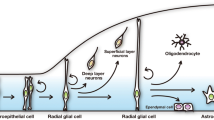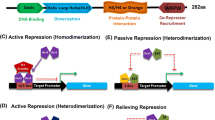Abstract
In the nervous system, Hes1 shows an oscillatory manner in neural progenitors but a persistent one in neurons. Many models involving Hes1 have been provided for the study of neural differentiation but few of them take the role of microRNA into account. It is known that a microRNA, miR-9, plays crucial roles in modulating Hes1 oscillations. However, the roles of miR-9 in controlling Hes1 oscillations and inducing transition between different cell fates still need to be further explored. Here we provide a mathematical model to show the interaction between miR-9 and Hes1, with the aim of understanding how the Hes1 oscillations are produced, how they are controlled, and further, how they are terminated. Based on the experimental findings, the model demonstrates the essential roles of Hes1 and miR-9 in regulating the dynamics of the system. In particular, the model suggests that the balance between miR-9 and Hes1 plays important roles in the choice between progenitor maintenance and neural differentiation. In addition, the synergistic (or antagonistic) effects of several important regulations are investigated so as to elucidate the effects of combinatorial regulation in neural decision-making. Our model provides a qualitative mechanism for understanding the process in neural fate decisions regulated by Hes1 and miR-9.











Similar content being viewed by others
References
Kohwi, M., Doe, C.Q.: Temporal fate specification and neural progenitor competence during development. Nat. Rev. Neurosci. 14, 823–838 (2013)
Shimojo, H., Ohtsuka, T., Kageyama, R.: Oscillations in notch signaling regulate maintenance of neural progenitors. Neuron 58, 52–64 (2008)
Kabos, P., Kabosova, A., Neuman, T.: Blocking HES1 expression initiates GABAergic differentiation and induces the expression of p21(CIP1/WAF1) in human neural stem cells. J. Biol. Chem. 277, 8763–8766 (2002)
Imayoshi, I., Isomura, A., Harima, Y., Kawaguchi, K., Kori, H., Miyachi, H., Fujiwara, T., Ishidate, F., Kageyama, R.: Oscillatory control of factors determining multipotency and fate in mouse neural progenitors. Science 342, 1203–1208 (2013)
Baek, J.H., Hatakeyama, J., Sakamoto, S., Ohtsuka, T., Kageyama, R.: Persistent and high levels of Hes1 expression regulate boundary formation in the developing central nervous system. Development 133, 2467–2476 (2006)
Hirata, H., Yoshiura, S., Ohtsuka, T., Bessho, Y., Harada, T., Yoshikawa, K., Kageyama, R.: Oscillatory expression of the bHLH factor Hes1 regulated by a negative feedback loop. Science 298, 840–843 (2002)
Monk, N.A.: Oscillatory expression of Hes1, p53, and NF-kappaB driven by transcriptional time delays. Curr. Biol. 13, 1409–1413 (2003)
Zeiser, S., Müller, J., Liebscher, V.: Modeling the Hes1 oscillator. J. Comput. Biol. 14, 984–1000 (2007)
Momiji, H., Monk, N.A.: Oscillatory Notch-pathway activity in a delay model of neuronal differentiation. Phys. Rev. E. 80, 021930 (2009)
Wang, R., Liu, K., Chen, L., Aihara, K.: Neural fate decisions mediated by trans-activation and cis-inhibition in Notch signaling. Bioinformatics 27, 3158–3165 (2011)
Bonev, B., Stanley, P., Papalopulu, N.: MicroRNA-9 Modulates Hes1 ultradian oscillations by forming a double-negative feedback loop. Cell Rep. 2, 10–18 (2012)
Goodfellow, M., Phillips, N.E., Manning, C., Galla, T., Papalopulu, N.: microRNA input into a neural ultradian oscillator controls emergence and timing of alternative cell states. Nat. Commun. 5, 3399 (2014)
Pillai, R.S.: MicroRNA function: multiple mechanisms for a tiny RNA? RNA 11, 1753–1761 (2005)
Pasquinelli, A.E.: MicroRNAs and their targets: recognition, regulation and an emerging reciprocal relationship. Nat. Rev. Genet. 13, 271–282 (2012)
Coolen, M., Katz, S., Bally-Cuif, L.: miR-9: a versatile regulator of neurogenesis. Front. Cell. Neurosci. 7, 220 (2013)
Zhao, C., Sun, G., Li, S., Shi, Y.: A feedback regulatory loop involving microRNA-9 and nuclear receptor TLX in neural stem cell fate determination. Nat. Struct. Mol. Biol. 16, 365–371 (2009)
Tan, S.L., Ohtsuka, T., González, A., Kageyama, R.: MicroRNA9 regulates neural stem cell differentiation by controlling Hes1 expression dynamics in the developing brain. Genes Cells 17, 952–961 (2012)
Conaco, C., Otto, S., Han, J.J., Mandel, G.: Reciprocal actions of REST and a microRNA promote neuronal identity. Proc. Natl. Acad. Sci. U.S.A. 103, 2422–2427 (2006)
Bredenkamp, N., Seoighe, C., Illing, N.: Comparative evolutionary analysis of the FoxG1 transcription factor from diverse vertebrates identifies conserved recognition sites for microRNA regulation. Dev. Genes Evol. 217, 227–233 (2007)
Shibata, M., Nakao, H., Kiyonari, H., Abe, T., Aizawa, S.: MicroRNA-9 regulates neurogenesis in mouse telencephalon by targeting multiple transcription factors. J. Neurosci. 31, 3407–3422 (2011)
Widder, S., Schicho, J., Schuster, P.: Dynamic patterns of gene regulation I: simple two-gene systems. J. Theor. Biol. 246, 395–419 (2007)
Uriu, K., Morishita, Y., Iwasa, Y.: Random cell movement promotes synchronization of the segmentation clock. Proc. Natl. Acad. Sci. U.S.A. 107, 4979–4984 (2010)
Zhou, W., Li, Y., Wang, X., Wu, L., Wang, Y.: MiR-206-mediated dynamic mechanism of the mammalian circadian clock. BMC Syst. Biol. 5, 141 (2011)
Zhou, P.P., Cai, S.M., Liu, Z.R., Wang, R.Q.: Mechanisms generating bistability and oscillations in microRNA-mediated motifs. Phys. Rev. E. 85, 041916 (2012)
Lai, X., Bhattacharya, A., Schmitz, U., Kunz, M., Vera, J., Wolkenhauer, O.: A systems’ biology approach to study microRNA-mediated gene regulatory networks. Biomed. Res. Int. 2013, 703849 (2013)
Kiparissides, A., Koutinas, M., Moss, T., Newman, J., Pistikopoulos, E.N., Mantalaris, A.: Modelling the Delta1/Notch1 pathway: in search of the mediator(s) of neural stem cell differentiation. PLoS ONE 6, e14668 (2011)
Jensen, M.H., Sneppen, K., Tiana, G.: Sustained oscillations and time delays in gene expression of protein Hes1. FEBS Lett. 541, 176–177 (2003)
Decroly, O., Goldbeter, A.: Birhythmicity, chaos, and other patterns of temporal self-organization in a multiply regulated biochemical system. Proc. Natl. Acad. Sci. U.S.A. 79, 6917–6921 (1982)
Leloup, J.C., Goldbeter, A.: Chaos and birhythmicity in a model for circadian oscillations of the PER and TIM proteins in Drosophila. J. Theor. Biol. 198, 445–459 (1999)
Pendergast, J.S., Niswender, K.D., Yamazaki, S.: The complex relationship between the light-entrainable and methamphetamine-sensitive circadian oscillators: evidence from behavioral studies of Period-mutant mice. Eur. J. Neurosci. 38, 3044–3053 (2013)
Kobayashi, T., Mizuno, H., Imayoshi, I., Furusawa, C., Shirahige, K., Kageyama, R.: The cyclic gene Hes1 contributes to diverse differentiation responses of embryonic stem cells. Genes Dev. 23, 1870–1875 (2009)
Hafizi, M., Atashi, A., Bakhshandeh, B., Kabiri, M., Nadri, S., Hosseini, R.H., Soleimani, M.: MicroRNAs as markers for neurally committed CD133+/CD34+ stem cells derived from human umbilical cord blood. Biochem. Genet. 51, 175–188 (2013)
Annibali, D., Gioia, U., Savino, M., Laneve, P., Caffarelli, E., Nasi, S.: A new module in neural differentiation control: two microRNAs upregulated by retinoic acid, miR-9 and -103, target the differentiation inhibitor ID2. PLoS ONE 7, e40269 (2012)
Indulekha, C.L., Divya, T.S., Divya, M.S., Sanalkumar, R., Rasheed, V.A., Dhanesh, S.B., Sebin, A., George, A., James, J.: Hes-1 regulates the excitatory fate of neural progenitors through modulation of Tlx3 (HOX11L2) expression. Cell. Mol. Life Sci. 69, 611–627 (2012)
Maddodi, N., Bhat, K.M., Devi, S., Zhang, S.C., Setaluri, V.: Oncogenic BRAFV600E induces expression of neuronal differentiation marker MAP2 in melanoma cells by promoter demethylation and down-regulation of transcription repressor HES1. J. Biol. Chem. 285, 242–254 (2010)
Wolf, J., Becker-Weimann, S., Heinrich, R.: Analysing the robustness of cellular rhythms. Syst. Biol. (Stevenage) 2, 35–41 (2005)
Tian, X.J., Zhang, X.P., Liu, F., Wang, W.: Interlinking positive and negative feedback loops creates a tunable motif in gene regulatory networks. Phys. Rev. E. 80, 011926 (2009)
Hart, Y., Alon, U.: The utility of paradoxical components in biological circuits. Mol. Cell 49, 213–221 (2013)
Acknowledgments
This research is supported by the National Natural Science Foundation of China (Grants 11171206 and 11331009)
Author information
Authors and Affiliations
Corresponding author
Rights and permissions
About this article
Cite this article
Li, S., Liu, Y., Liu, Z. et al. Neural fate decisions mediated by combinatorial regulation of Hes1 and miR-9. J Biol Phys 42, 53–68 (2016). https://doi.org/10.1007/s10867-015-9391-2
Received:
Accepted:
Published:
Issue Date:
DOI: https://doi.org/10.1007/s10867-015-9391-2




